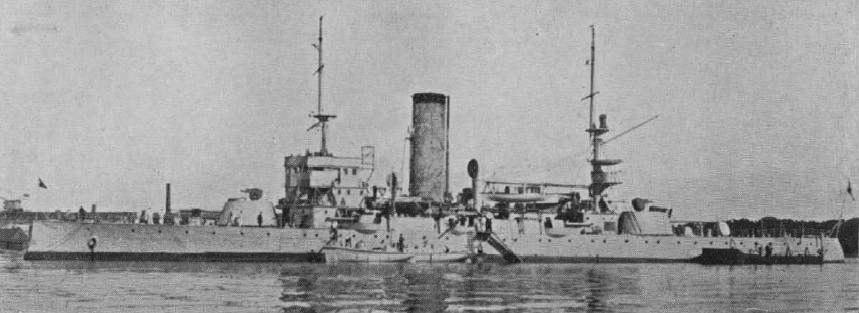
The Norwegian Capital Ships of two wars
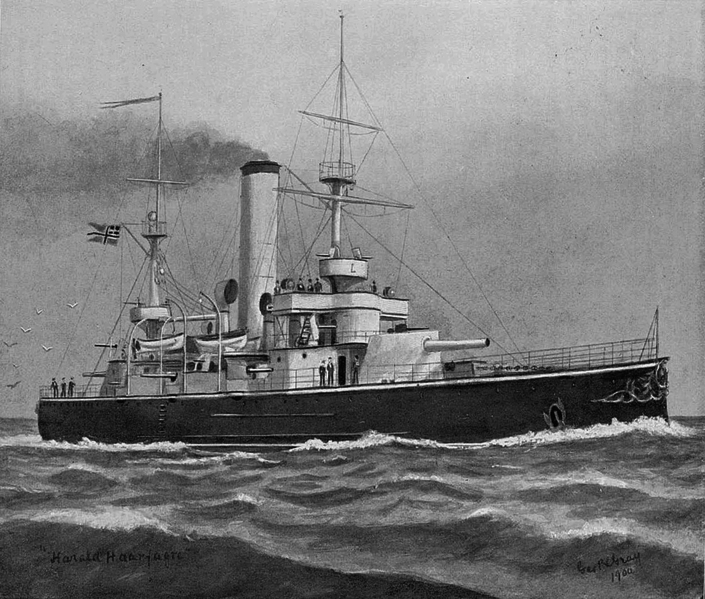
Brassey’s engraving, Brassey’s naval annual 1900
HNoMS Tordenskjold and Harald Haarfagre constituted for 50 years the bulk of Norwegian naval defence. They were ordered as part as the general rearmament until the 1905 union separation from Sweden and with the lighter, more modern Eidsvold class formed the backbone of the Royal Norwegian Navy until retired on the mid-1930s. This did not ended their career there, as both were captured by the Germans which used them as floating batteries (Flakschiff), and they were only BU in 1948.
The small Royal Norwegian Navy capitalized like the others Scandinavian Navies on a particular coastal defence asset, aside mines, torpedo boats and coastal batteries: Coastal Battleships. In Norwegian this was even more generic as “panserskipet” (armoured ship). Both were misleading and that’s why modern consensus is simply to call them “coast defence ships”, which also concerned similar vessels in the Swedish, Finnish, Dutch and Danish Navies. They lacked indeed a lot to be compared to true sea going battleships: Better speed, range armor, and armament. Their purpose was mostly to deter cruisers and destroyers in a combined arms defence. If their concept was relevant in WWI, it was no longer so in the interwar, notably due to new long-range artillery, the danger of submarines and aviation.
Their role changed, but even though they stayed active from the mid-1930s as training vessels, potentially doubling as harbor defence ships in case of war. With Operation Weserübung (German invasion of Norway) in 1940 both were seized and requitioned by the Kriegsmarine to be converted as Flak batteries. They ended as barrack ships postwar, then were sold for scrapping.
Design of the Tordenskjold class
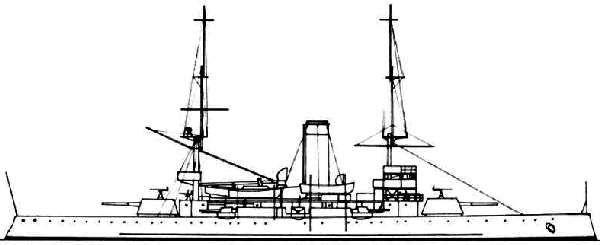
Conway’s profile
The Harald Haarfagre and Tordenskjold, followed by the Eidsvold and Norge were part of a general rearmament intended to protect Norway against a possible military action by Sweden until the 1905 dissolution of the Swedish-Norwegian personal union. The Norwegian Parliament authorized the construction of four new Panserskipp in 1895 to replace the existing, obsolete monitors. Political tensions led them to be ordered in Britain, all four. In 1896, Armstrong Whitworth shipyard was conformed an order for two 3,500 tons vessels armed with two Vickers 21 cm guns and 12 cm artillery as secondary battery. They were mentioned as very comparable to the German Siegfried class.
Thes vessels were designed and built like pre-dreadnought battleships in reduction. They were well suiteed between their draft and diemnsions to the fjords and narrow waters of the rugged coast of the country and carried a full barrery betwen German-built 21cm, 12cm, 7.6 cm and 1-pdr guns, while the protection was designed to withstand similar similar caliber artillery (notably heavy cruisers) but it was not enough to resist shells above 10 inches, nor underwater attacks due to unsufficient compartimentation. They used Harvey Armour, between 7 to 8 inches for the best protected parts.

Top view, Conway’s
They had a symmetrical appearance, relatively low feeboard and flush deck preventing their use on rough weather and open sea in the north Atlantic, two tall masts and a single, tall funnel. The appearance indeed mimicked those of pre-dreadnoughts, which could play in part as deterrence. Both were built in Great Britain, at Vickers-Arsmtrong yard. They were built quickly, at Low Walker shipyard short of civilian orders at the time, rather than in Elswick. Harald Haarfagre was laid down on 18 March 1896, launched on 4 January 1897 and completed on 10 June 1897 and Tordenskjold laid down on 18 March 1896, launched on 10 Mar 1897 and completed on 2 April 1898.
About their names, “Tordenskjold” was the nickname of sea hero Peter Wessel and “Harald Haarfagre” (Harold “fair hair”), the first king of Norway (c. 850 – c. 932) which became a national icon of Norway and symbol of independence, conciding with the expected political split with Sweden.
Hull and general design
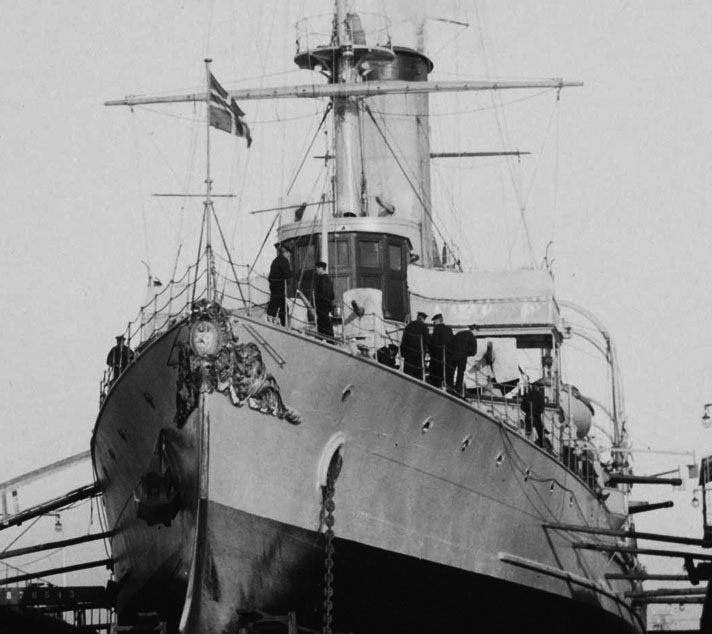
These armored ships intended for coastal waters became in any case, the largest Norwegian warships ever in service, later completed by the similar, but smaller Eidsvold class.
These ships displaced 3,852 tonnes standard, probably around 3,920 fully loaded. The hull was 92,66 meter long (304 ft) overall, 85.34 m (280 ft) between perpendiculars and 14,78 meter in beam (48 ft 6in) for a draft of 5,38 meters (17ft 8in). The ratio was favourable to speed, but still they were manoeuvrable. When first built, their forward bridge was open, built above the conning tower. Later in the 1910s, a fully enclosed bridge was built above, with an open bridge on top. The tall, 4-segmented masts fore and aft supported telegraphy cables, and also two fighting tops each, platforms carrying a projector for the lower one. The lower fighting top aft had light 1-pdr guns installed.
The central “island” suprestructure was built around the large funnel, with all the secondary artillery on sponsons, and the service boats located between the funnel and aft mast.
Armour protection layout
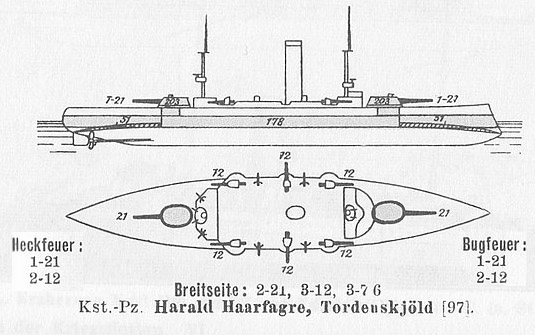
Armour details in a German publication of the time.
As said above, they had Harvey armor for theior main Belt 7 in (178 mm) amidships, covering the machinery space, barbettes and ammunition magazines, then it was tapered down to 4 in (102 mm) to both ends. The main turrets were protected by 8 inches walls (203 mm) with 5 inches (127 mm) on their roof and back. The conning tower had walls 6-in thick (152 mm). The armoured deck’s thickness is unknow, likely 5-in. The secondary 4.5-in guns had protective shields only stopping shrapnels.
Powerplant
These vessels had to shafts connected to two Vickers Coal-fired vertical triple-expansion steam engines, fed by two Yarrow 3-drum horizontal boilers, which were rated for a total of 4,500 ihp (3,356 kW). This was enough to ensure a top speed of 16.9 knots (31.3 km/h; 19.4 mph), which was good for a coastal ship and close to pre-dreadnought standards. Autonomy was limited (3,000 nm?) since they only carried 550 tons of coal in normal conditions.
Armament
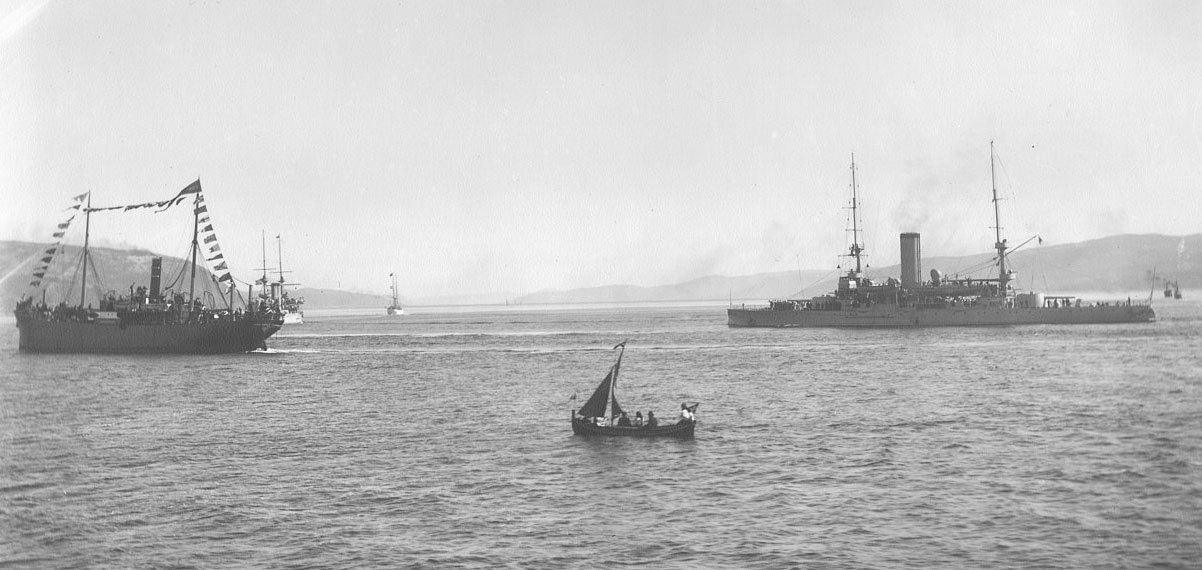
At the roadstead of Trondhjem, 1906
Main
These ships mirrored pre-dreadnoughts with a main turret fore and aft of the central superstructure. The first difference was the single turret, instead of twin, and 21 cm L/44 (8.26 in) caliber instead of 12-in (300 mm). A substantial difference, more to scare off cruisers than battleships they were not designed to engage.
These 21 cm Skl/45 were not Krupp guns, but rather were classed Arsmstrong nomenclature. These were officially 209mm/44 Armstrong B types (no specs).
They had similarities though with the Krupp 21 cm Schnelladekanone Länge 40 used on the Victoria Luise class protected cruisers. The TL C/97 could elevate to 30°, and had a 4-5 rounds per minute fire rate. Range should be around and beyond 18 km (12 mi) at +30°.
Secondary
The Tordenskjold class was given a secondary battery of Armstrong 120mm/44 Armstrong Y type guns, six of them along the central superstructures in sponons and under shields. Produced by Elswick, they were specific to these export designs (no more info available). They could reach a target 10,000 yards (9,000 m) away at 20° and fired at a rate of 6 round per minuute in ideal conditions.
Anti-Torpedo Boat Armament
To defend themselves against torpedo boats, these coast defence ships had a battery of six 12 pdr-QF (standard 75 mm Vickers guns) located on the turrets (2), forward bridge (2) and aft superstructure (2). Same specs as standard Armstrong 12-Pdr QF of the time.
This was completed by six 1.5 pdr (37 mm) Hotchkiss guns, four in the broadsides under masks, two aft, and possibly later according to photos two in a forward fighting top.
They also carried for close quarters a pair of 450 mm torpedo tubes, placed in the beam, fixed above the belt. Standard Whitehead 18-in type of the era.
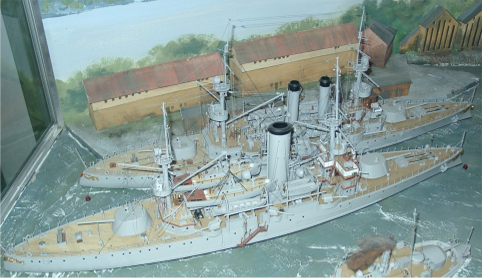
Models of the HNoMS Eidsvold and HNoMS Tordenskiold
⚙ Tordenskjold-class specifications |
|
| Displacement | 3,380t standard, 3858t FL |
| Dimensions | 92.7 oa x 14.8 x 5.38 max ( x x feets) |
| Propulsion | 2 shafts VTE, 3 cylindrical boilers, 4,000 shp |
| Speed | 16.9 kts () |
| Range | coal 500 tons, 5,000 nm at 10 kts |
| Armament | 2x 209mm/44, 6x 120mm/44, 6x 76mm/40, 6x 37mm/45 Hotchkiss, 2x 450mm TTs |
| Protection | Belt: 178-100mm, turrets 203-127mm, decks 51-37mm, CT 152mm |
| Crew | 245 |
Career of the Tordenskjold class
 Tordenskjold class
Tordenskjold class
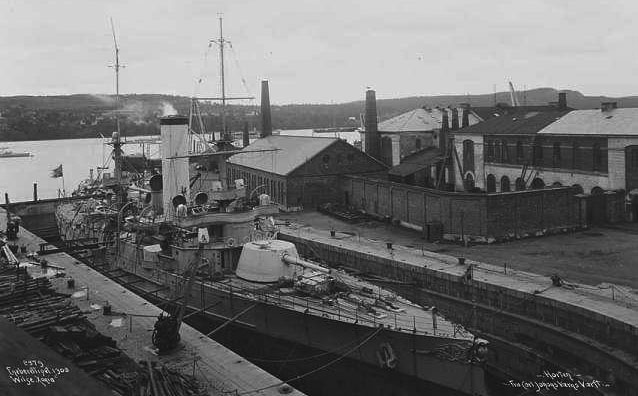
The admiralty dispute (1901-1910)
There was great disagreement within the Norwegian fleet command about their use when Norway declared independence. On one hand, they did not want to provoke Sweden by mobilizing too many and too large forces and on the other still wanted to leave no doubt about their will to defend the country. Commanding admiral Vice-Admiral Christian Sparre and his chief of staff, Rear-Admiral Jacob Børresen disagreed strongly on these points, leading to emerging factions and endless debates in which the new armored ships were central.
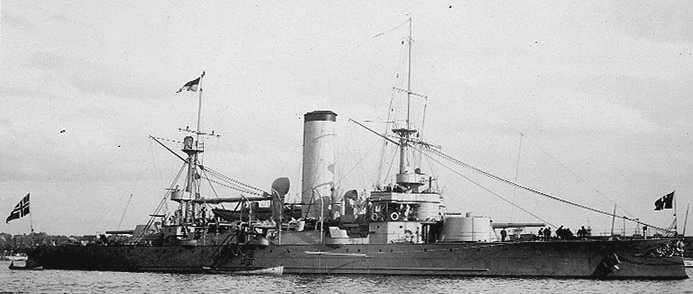
Disagreements also emerged about their supposed battle tactics. Jacob Børresen wanted to meet the Swedish squadron at sea head-on and force it to retreat, whereas Christian Sparre wanted to keep them safer at Tønsberg, to prevent a landing of Swedish troops there. He wanted them not concentrated ina single squadron but at the contrary to have them distributed in several local forces completed by cruisers and torpedo boats. The final word was that no suitable tactics had been designed for a possible fight against the Swedes, while the Norwegian navy was just too new and freshly equipped with these modern vessels to develop any experience of this kind.
The bitter “admiral dispute” was not settled until 1910. There was an arbitration court, set up in the Legislative Hall in the Storting. The later reviewed all arguments and data for many hourse and concluded by ruling against VADM C. Sparre, forced to seek resignation from his position as commanding admiral. Børresen however was not spared criticism for his performance in 1905 and also had to resign.
Norway indeed declared independence by 7 June 1905, and both Børresen and Sparre trained intensively with their new armored ships and torpedo boats in the Oslo Fjord. Three months of continuous exercises in all kinds of weather brought some drilling experience until the squadron was disbanded on 29 July. In the meantime, the Swedes also built up their largest battle fleet in Gothenburg harbor, and on 13 September they were mobilized, fully coaled, manned, supplies in ammunition and ready to go. Tension only lessened on 14 October, then the crisis was diffused by negociations and the crews received a leave.
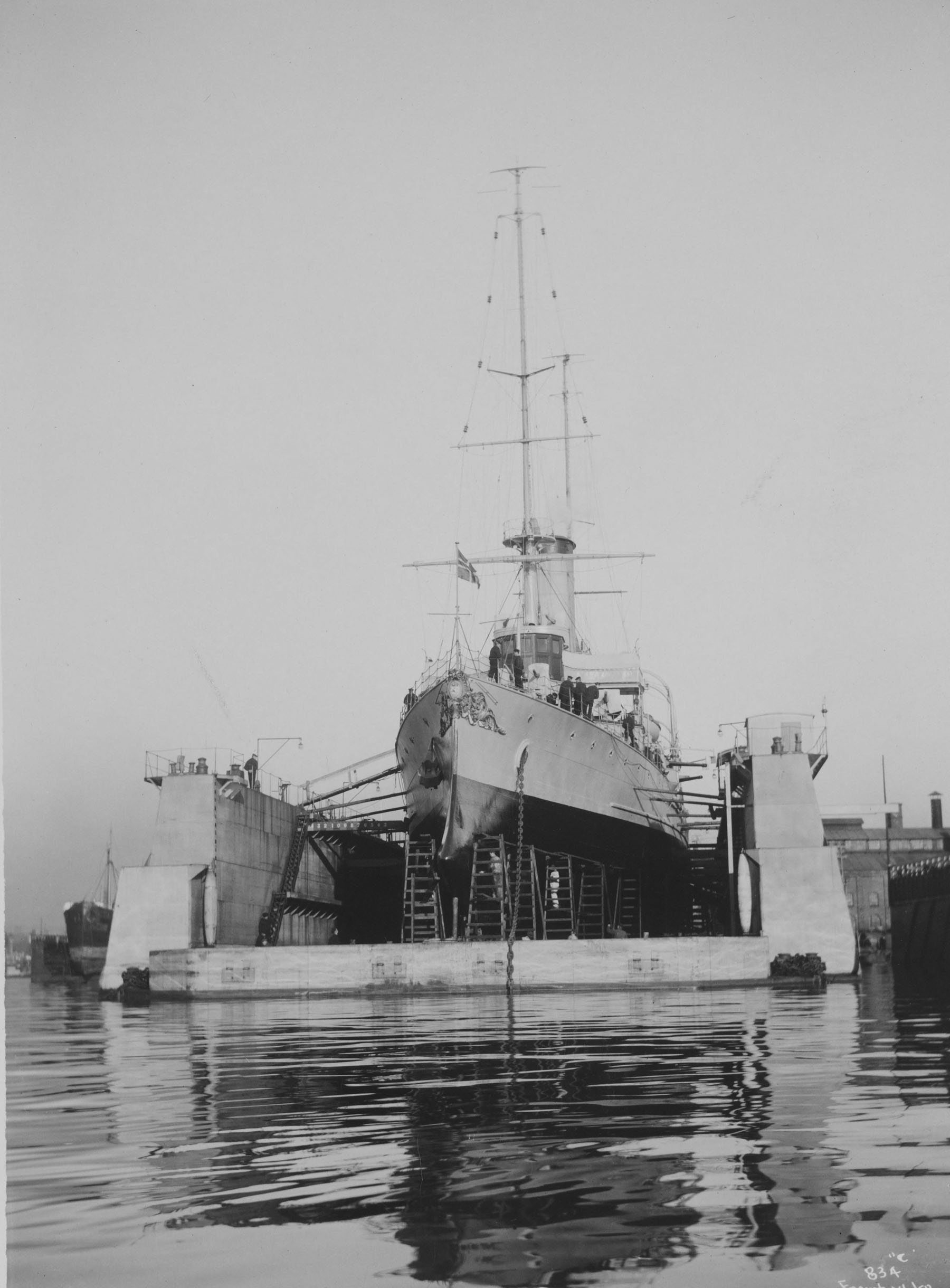
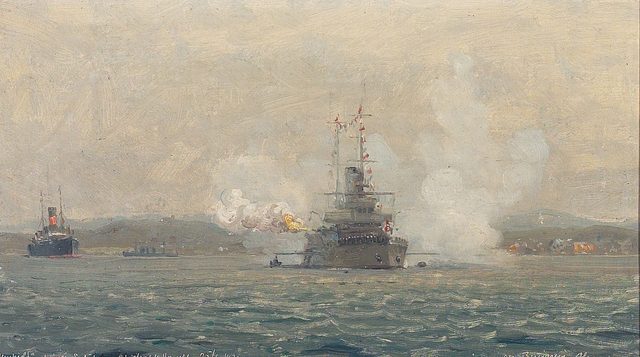
Christian_Benjamin_Olsen_Tordenskjold_saluting_for_det_islandske_kongeflag_25-6_1930
Pre- and WWI service
The Harald Haarfagre class stayed grouped together. They provided routine exercizes and training trips, in 1901 they both made a long training cruise along the Norwegian coast with the sister ship Tordenskjold plus the newly completed HNoMs Norge and the destroyer Valkyrjen. Harald Haarfagre made foreign visits alone as well, including a visit to the United States in 1907, marking the 300th anniversary of the first settlement of the United States. She arrived in New York on June 18 with 25 additional sea cadets on board, first Norwegian warship there after independence. She proceeded to Hampton Roads, visited the Jamestown Exhibition accompanied with the brand new armored cruiser Fylgia. She then proceeded for home via Madeira in portugal. In 1911, she visited Copenhagen, escorting the Norwegian state yacht of King Haakon VII. During the “great war”, from 1914, Harald Haarfagre remained widely in home waters, to ensure Norwegian neutrality.
Until 1918, Tordenskjold made also training trips and foreign visits. In 1900, she took part in a visit to Kiel by a Norwegian formation included the gunboat Frithjof, destroyer Valkyrjen and the four new Storm class torpedo boats. In, 1901 she made a long voyage along the Norwegian coast with her sister ship Haarfagre, and Norge plus the destroyer Valkyrjen.
As World War I broke out she also remained in Norwegian waters but from 1918 she became a training ship, and later made a total of 18 training trips. In 1923, she had twi new anti-aircraft guns installed. By August 29, 1933, a shell exploded in one of her 21 cm gun turret, causing four dead and several injured sailors. By the very end of the 1930s she was retired due to obsolescence, becoming an utility Hulk with her two 21 cm guns removed as most of her secondary and light artillery, a new one fitted (see above).
In WW2
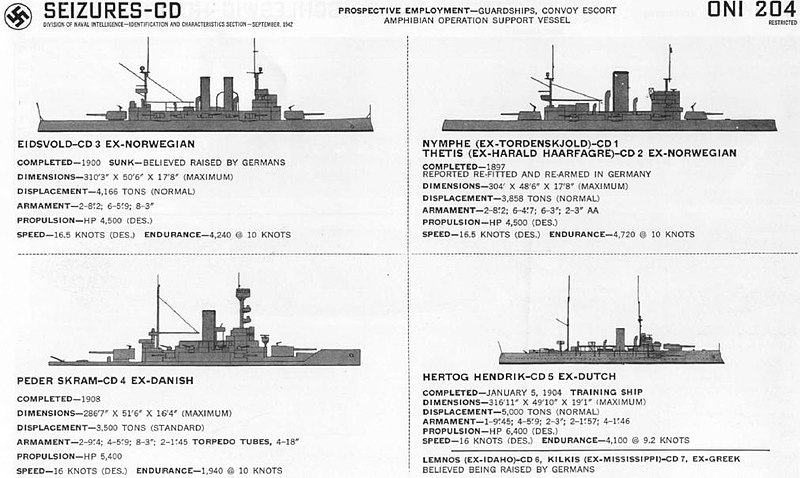
Post-WWI, there were some modernization attempts carried out in the 1920s. In 1923 both received two extra 47mm/46 QF Mk I guns capable of AA fire. No info is available about the modernization of their fire control systems however. In in the second half of the 1930s, Harfaarge was decommissioned due to obsolescence. She became a storage hulk, disarmed, as her two 21 cm guns were removed and recycled in coastal artillery (they will see action in 1940). However, her machinery remained fully operational if needed. However with the war starting in 1939 they were rearmed with two single 76mm/28 Bofors M36 guns and two single 20mm/70 Oerlikon M36 AA guns plus two 12.7mm/90 (0.5 in) AA heavy machine guns.
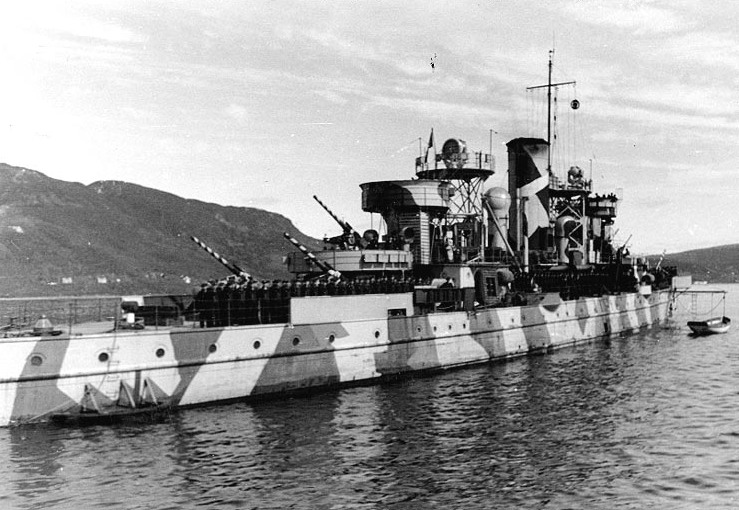
Then came WW2 and the Norwegian Campaign (Operation Weserübung): During the German occupation they both fell into German hands, were thoroughky inspected and their engines tests, still showed a top speed of around 14 knots. So they sailed to Kiel in Germany in order to be modernized and reused, converted as floating anti-aircraft battery (FLAKschiff) returning into service for the Kriegsmarine on February 1, 1941 for Harfaarge, renamed KMS Thetis.
Their displacement rose to 3,858 tonnes, armament consisting of six twin 10.5 cm Flak 38, two Bofors 4 cm Flak and fourteen 2 cm Flak 30. Her bridge was modernized, she had two tall projectors tops, a new pole mast with wireless radio. It seems KMS Nymphe was not armed exactly the same way, with only five twin 10.5 cm FLAK 38.
Unlike most FLAKschiffs of the Kriegsmarine, Nymphe and Thetis were among the only ines capable to move under their own power, making them precious for point-defence. KMS Thetis stayed in northern Norway, stationed in the Ofotfjord, off Narvik and later in the Altafjord, providing AA protection for the battleship Tirpitz. It was not that successful as operations showed.
In the last days of the war, KMS Thetis was located in Kilbotn Bay, south of Harstad, where a U-Boat base was stationed from the autumn of 1944. She survived a massive air raid by the Royal Navy on May 4, 1945, called Operation Judgment, destroying residential area and the depot ship Black Watch, plus sinking the U-Boat U-711. However Thetis remained largely unscathed due to her locations on the west bank of the bay, and due to the relief around and camouflage, did not offer an easy target.
On her side, Tordenskjold also fell into German hands and sailed to Kiel to be converted, recommissioned on February 1, 1941 as KMS Nymphe, 3,858 t in displacement with the same armament, but in 1944, she received two additional 20mm Flakvierling (quad mounts). She was initially stationed in Kiel, but transferred to Tromsø in August 1941. Like her sister ship she was used to protect Tirpitz in her anchorage in northern Norway. After her sinking on November 12, 1944, KMS nymph was moved back to Kiel, staying there until the end of the war.
Postwar Fate
After the German surrender in May 1945, Nymphe was taken back to Narvik by its German crew, to be returned to Norway. She however ran aground underway on May 17, 1945, partially sinking. She was eventually raised and given back her old name, her AA guns removed and still used as part of the coastal artillery. The hull used as a residential ship for some time but by 1947 it was sold for BU, scrapped in 1948.
On her side Haarfarge was just at the right place after the war, she was just reverted to her original name. The anti-aircraft guns were removedand recycled into the coastal artillery while her hull was reused as as accomodation barrack, notably transporting German POW back home from Norway. In 1947, she was sold for scrap, which was done in 1948.
Read More
Books
Frank Abelsen: Norwegian naval ships 1939–1945. Sem & Stenersen, Oslo, 1986 (S. 290)
Peter Brooke: Warships for Export: Armstrong Warships 1867–1927, World Ship Society, Gravesend (1999)
Robert Gardiner (Hg.): Conway’s All the World’s Fighting Ships 1922–1946. Conway Maritime Press, London, 1987.
Hans H. Hildebrand, Albert Röhr, Hans-Otto Steinmetz: Die deutschen Kriegsschiffe, Mundus Verlag, Ratingen, 1979
Bruno Weyer: Taschenbuch der Kriegsflotten 1905, 2. Auflage, J.F. Lehmann Verlag, München auf archive.org
Links
https://web.archive.org/web/20070811224748/http://borreminne.hive.no/aargangene/2004/22-boerresen1905.htm#_ftn2
https://no.wikipedia.org/wiki/Tordenskjold-klassen
https://de.wikipedia.org/wiki/Harald_Haarfagre_(Schiff,_1897)
https://en.wikipedia.org/wiki/HNoMS_Harald_Haarfagre
https://en.wikipedia.org/wiki/Tordenskjold-class_coastal_defence_ship
http://www.german-navy.de/kriegsmarine/ships/aabattery/thetis/history.html
http://www.navypedia.org/ships/norway/no_bb_harald_haarfagre.htm
http://www.navweaps.com/Weapons/WNBR_Main.php

 Latest Facebook Entry -
Latest Facebook Entry -  X(Tweeter) Naval Encyclopedia's deck archive
X(Tweeter) Naval Encyclopedia's deck archive Instagram (@navalencyc)
Instagram (@navalencyc)





 French Navy
French Navy Royal Navy
Royal Navy Russian Navy
Russian Navy Armada Espanola
Armada Espanola Austrian Navy
Austrian Navy K.u.K. Kriegsmarine
K.u.K. Kriegsmarine Dansk Marine
Dansk Marine Nautiko Hellenon
Nautiko Hellenon Koninklije Marine 1870
Koninklije Marine 1870 Marinha do Brasil
Marinha do Brasil Osmanlı Donanması
Osmanlı Donanması Marina Do Peru
Marina Do Peru Marinha do Portugal
Marinha do Portugal Regia Marina 1870
Regia Marina 1870 Nihhon Kaigun 1870
Nihhon Kaigun 1870 Preußische Marine 1870
Preußische Marine 1870 Russkiy Flot 1870
Russkiy Flot 1870 Svenska marinen
Svenska marinen Søværnet
Søværnet Union Navy
Union Navy Confederate Navy
Confederate Navy Armada de Argentina
Armada de Argentina Imperial Chinese Navy
Imperial Chinese Navy Marinha do Portugal
Marinha do Portugal Mexico
Mexico Kaiserliche Marine
Kaiserliche Marine 1898 US Navy
1898 US Navy Sovietskiy Flot
Sovietskiy Flot Royal Canadian Navy
Royal Canadian Navy Royal Australian Navy
Royal Australian Navy RNZN Fleet
RNZN Fleet Chinese Navy 1937
Chinese Navy 1937 Kriegsmarine
Kriegsmarine Chilean Navy
Chilean Navy Danish Navy
Danish Navy Finnish Navy
Finnish Navy Hellenic Navy
Hellenic Navy Polish Navy
Polish Navy Romanian Navy
Romanian Navy Turkish Navy
Turkish Navy Royal Yugoslav Navy
Royal Yugoslav Navy Royal Thai Navy
Royal Thai Navy Minor Navies
Minor Navies Albania
Albania Austria
Austria Belgium
Belgium Columbia
Columbia Costa Rica
Costa Rica Cuba
Cuba Czechoslovakia
Czechoslovakia Dominican Republic
Dominican Republic Haiti
Haiti Hungary
Hungary Honduras
Honduras Estonia
Estonia Iceland
Iceland Eire
Eire Equador
Equador Iran
Iran Iraq
Iraq Latvia
Latvia Liberia
Liberia Lithuania
Lithuania Mandchukuo
Mandchukuo Morocco
Morocco Nicaragua
Nicaragua Persia
Persia San Salvador
San Salvador Sarawak
Sarawak Uruguay
Uruguay Venezuela
Venezuela Zanzibar
Zanzibar Warsaw Pact Navies
Warsaw Pact Navies Bulgaria
Bulgaria Hungary
Hungary

 Bundesmarine
Bundesmarine Dutch Navy
Dutch Navy Hellenic Navy
Hellenic Navy Marina Militare
Marina Militare Yugoslav Navy
Yugoslav Navy Chinese Navy
Chinese Navy Indian Navy
Indian Navy Indonesian Navy
Indonesian Navy JMSDF
JMSDF North Korean Navy
North Korean Navy Pakistani Navy
Pakistani Navy Philippines Navy
Philippines Navy ROKN
ROKN Rep. of Singapore Navy
Rep. of Singapore Navy Taiwanese Navy
Taiwanese Navy IDF Navy
IDF Navy Saudi Navy
Saudi Navy Royal New Zealand Navy
Royal New Zealand Navy Egyptian Navy
Egyptian Navy South African Navy
South African Navy






























 Ukrainian Navy
Ukrainian Navy dbodesign
dbodesign